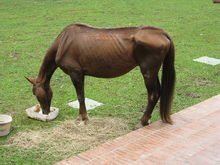Newsdate: May 19, 2025 - 8:30 am
Location: GILROY, California
Tips for feeding the geriatric horse or toothless horse

Special easy-to-chew feed for toothless horse
When feeding a horse with no teeth or with very severe tooth damage, feed a slurry of complete pelleted feed and/or mashed alfalfa pellets, and add in some long stemmed soft leafy alfalfa hay because horses without teeth will still want to chew on fiber.
© 2016 by George Donnelly
Feed frequent meals. Feed three to four equal size meals per day -- because a horse's stomach is very small and cannot hold a large amount of feed at one time -- or feed at least twice a day on a regular schedule. But don't over-feed your horse; too much feed at one time can cause digestive upsets.
Feed highly digestible feeds and good quality forage. Hay should be bright green, leafy and fine textured, with a fresh, pleasant aroma. Mold, dust, weeds and other foreign material in hay can be unhealthy. Color is an indicator of quality and nutrient content; good hay is bright green.
Most nutrients in hay are in the leaves, and soft leafy hay is a valuable source of feed. Leafiness is influenced by the kind of hay, its maturity when cut, the weather conditions while growing and curing the hay. Always, avoid feeding moldy or dusty hay. Inhaling dust over time, results in chronic obstructive pulmonary disease (COPD) or heaves in horses.
Another processed feed for tooth-challenged horses is extruded feed, which is uniformly mixed feed similar to pet food. This process helps older horses better absorb their feed.
Feed the special needs horse individually if needed. Make sure the older or tooth-challenged horse gets to eat his ration and the boss horse is not cleaning up all the feed. Ration changes should be made gradually (over a minimum of five days) to prevent digestive disturbances.
What can you add to the older horse's diet?
If you have a horse that is a hard keeper and you cannot get the horse to eat enough calories, add 1/4 to 1/2 cup of oil (corn or vegetable) to the grain. Some research has shown, due to decreased feed efficiency geriatric horses may need to be fed similar to the NRC requirement for yearling and weanlings when it comes to vitamins and minerals.
Feed a high quality protein, 14%. Add vitamin C to the diet, if the horse shows signs of a compromised immune system (supplementation of vitamin C at 5 to 10 grams a day). B vitamins can be fed for pituitary tumors (Cushing's disease) and liver disease. A good source of vitamin B is brewer's yeast; it improves feed utilization and health of the gut microflora.
Top 5 takeaways - Feeding the toothless horse
Many older horses have difficulty chewing properly, as do some younger horses. Whether it is because of lost teeth, worn teeth, gum problems, or jaws that are misaligned and don't work well together, making chewing and eating easier with special diet considerations will result in better nutrition, a healthier horse, and less waste of good feed.
- Consider the form of the feed being given to the horse. Adding some warm water to the feed 10 to 15 minutes before feeding will allow the dentally challenged horse to chew and swallow more easily and will also reduce the chances of choking and colic.
- Selection of the feed is important for a toothless or dentally challenged horse. A senior horse feed with a high fat level of 6 - 10% and containing highly digestible fiber sources, such as beet pulp, is easily digested and can replace much of the hay that the horse would normally consume.
- For the horse with serious dental challenges, add some high quality hay to promote intestinal motility. Although most senior feeds are high in fiber and can be fed as complete feeds, the horse needs enough bulk to maintain intestinal motility. Hay cubes or chopped forage can be soaked and mixed into the feed or fed separately. If the horse is able to eat high quality regular hay, separate the flakes and scatter them in small piles so that the horse walks from one pile to another. This will help the digestive tract and will provide a grazing effect for the horse.
- For horses affected by Cushing's disease, choose feed with low amounts of sugar and starch, which could improve glucose and insulin metabolism and reduce the risk of laminitis and founder.
- Unless your dentally challenged or toothless horse is the most dominant horse in the group, feed him separately to give him enough time to finish his feed without interference from other horses.
